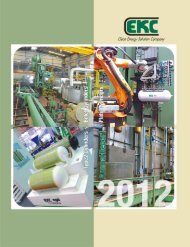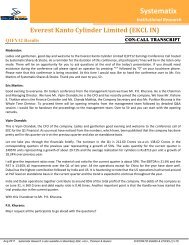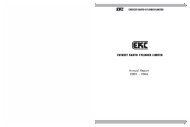Download PDF - Everest Kanto Cylinder Ltd.
Download PDF - Everest Kanto Cylinder Ltd.
Download PDF - Everest Kanto Cylinder Ltd.
You also want an ePaper? Increase the reach of your titles
YUMPU automatically turns print PDFs into web optimized ePapers that Google loves.
Annexure I<br />
SIGNIFICANT ACCOUNTING POLICIES:<br />
A. Basis of preparation of financial statements:<br />
The financial statements are prepared under the historical<br />
cost convention on the accrual basis of accounting in<br />
accordance with the generally accepted accounting<br />
principles, the applicable mandatory Accounting Standards<br />
and the relevant provisions of the Companies Act, 1956.<br />
B. Use of Estimates:<br />
The preparation of financial statements in conformity with<br />
generally accepted accounting principles requires<br />
estimates and assumptions to be made that affect the<br />
reported amounts of assets and liabilities on the date of the<br />
financial statements and the reported amounts of revenues<br />
and expenses during the reporting period. Differences<br />
between actual results and estimates are recognised in the<br />
period in which the results are known.<br />
C. Recognition of Revenue and Expenditure:<br />
a. Revenue / Income and Cost / Expenditure are generally<br />
accounted for on accrual as they are earned or incurred<br />
except in case of significant uncertainties;<br />
b. Sale of goods is recognized on transfer of significant<br />
risks and rewards of ownership. Recognition in the case<br />
of local sales is generally on the despatch of goods.<br />
Export Sales are generally accounted for on the basis<br />
of the dates of ‘On Board Bill of Lading’;<br />
c. Export Benefits are recognised in the year of export;<br />
d. Share Issue Expenses are charged first against<br />
available balance in the Securities Premium Account;<br />
e. Dividend income is recognised in the year in which the<br />
right to receive dividend is established.<br />
D. Employee Benefits:<br />
a. Short term employee benefits are recognised as an<br />
expense at the undiscounted amount in the Profit and<br />
Loss Account of the year in which the related service is<br />
rendered;<br />
b. Post employment benefits<br />
i. Defined contribution plans:<br />
Company’s contribution to the superannuation<br />
scheme, state governed provident fund scheme,<br />
etc. are recognised during the year in which the<br />
related service is rendered;<br />
ii. Defined benefit plans:<br />
The present value of the obligation under such<br />
plans is determined based on an actuarial<br />
valuation using the Projected Unit Credit Method.<br />
Actuarial gains and losses arising on such<br />
valuation are recognised immediately in the Profit<br />
EVEREST KANTO CYLINDER LIMITED<br />
and Loss Account. In the case of gratuity which is<br />
funded with the Life Insurance Corporation of<br />
India, the fair value of the plan assets is reduced<br />
from the gross obligation under the defined benefit<br />
plan to recognise the obligation on net basis;<br />
c. Long term compensated absences are provided on<br />
the basis of an actuarial valuation;<br />
d. Termination Benefits are recognised as an expense<br />
in the Profit and Loss Account of the year in which they<br />
are incurred.<br />
E. Foreign Currency Translations:<br />
a. All transactions in foreign currency are recorded at the<br />
rates of exchange prevailing on the dates when the<br />
relevant transactions take place;<br />
b. Monetary assets and liabilities in foreign currency<br />
outstanding at the close of the year are converted in<br />
Indian Currency at the appropriate rates of exchange<br />
prevailing on the date of the Balance Sheet. Resultant<br />
gain or loss is accounted for during the year;<br />
c. In respect of forward exchange contracts entered into<br />
to hedge foreign currency risks the difference between<br />
the forward rate and exchange rate at the inception of<br />
the contract is recognized as income or expense over<br />
the life of the contract. Further, the exchange differences<br />
arising on such contracts are recognised as income or<br />
expense along with the exchange differences on the<br />
underlying assets / liabilities. Profit or loss on<br />
cancellations / renewals of forward contracts is<br />
recognised during the year;<br />
d. Exchange differences arising on other derivative<br />
contracts entered into to hedge foreign currency<br />
exposure on account of highly probable forecast<br />
transactions, were recognized and marked to market,<br />
in line with principles laid down in Accounting Standard<br />
30 – Financial Instruments – Recognition and<br />
Measurement, issued by The Institute of Chartered<br />
Accountants of India, to the extent, no specific<br />
accounting treatment is prescribed under Company<br />
law or by any other regulatory authority. Accordingly,<br />
such gain or loss on effective hedges was carried<br />
forward under Hedging Reserve to be recognized in<br />
the Profit and Loss Account only in the year in which<br />
underlying transactions are complete. In the absence<br />
of a designation as effective hedge, the gain or loss<br />
would be immediately recognized in the Profit and Loss<br />
Account. With effect from 1st April, 2010, the Company<br />
has discontinued the aforesaid accounting treatment<br />
and is accordingly, recognizing mark to market losses<br />
in the Profit and Loss Account (Refer Note ‘21’ in<br />
Schedule ‘U’)<br />
Schedules forming part of Financial Statements Annual Report 2010-11<br />
44







